[technical post] explain the most error-prone link of Italian concentration-- cloth powder and pressing powder
For professional baristas, please follow the coffee workshop (Wechat official account cafe_style)
Espresso Espresso can be called the soul of Italian coffee and the foundation of all fancy coffee and flower drawing art.
Many friends have been asking the editor how to make milk foam and how to pull flowers, but they seldom ask how to extract Italian concentrate and how to make a delicious espresso in a cup.
Doesn't everyone drink Espresso?

After watching the videos sent by many friends, the editor found the most easily ignored and error-prone link-cloth powder and powder pressing. Today, let's explain:
Cloth powder
In the daily operation of most baristas, the following seven methods of powder distribution are mainly used:
1
Square cloth powder method:

Tilt your palms forward, tilt about 30 to 45 degrees, relax and straighten, touch the coffee powder pile with the flattest part of your index finger, then gently push the surface powder layer back and forth, left and right, so that the coffee powder fills the bowl evenly. The action essentials of the four methods are simple and easy to master, and they are the commonly used way of distributing powder.
Comments: many newcomers will use this cloth powder method, but in fact, what you wipe out is only the surface part of the coffee powder, and the coffee powder in the lower layer and the edge is still unevenly distributed. After pressing the powder, the density of different parts is different.
2
Rotating cloth powder method:

The action is similar to the four methods, but it changes the action of pushing the powder pile in a straight line, instead of rotating with both hands, pushing the powder pile to rotate in the powder bowl, and finally completing the cloth powder. The rotation method requires a certain degree of hand coordination and movement accuracy, and has the advantage of making the powder pile more tightly on the ground to cover the edge of the powder bowl. In practice, many baristas like to use the combination of the first four methods and then the Wechsler method to get a uniform powder distribution result.
Comments: this method is a little better than the four methods: at least the edges are more evenly distributed, and the effect and efficiency will be improved, but the above defects still can not be solved: the coffee powder in the lower layer is not as smooth as it looks.
3
Tap up and down:

After receiving the powder, gently knock the handle down on the handle bracket once or twice to make the powder pile in the powder bowl more dense. It is an auxiliary action before the cloth powder. This method makes the coffee powder pile denser and helps to increase the amount of powder that can be contained in the powder bowl. When tapping the handle lightly, be sure to go straight up and down, and the strength and times of each operation should be the same, so as to avoid causing additional variables, otherwise it will interfere with the evaluation of the extraction results.
Comments: this method can effectively eliminate the large "gap" in the upper and lower powder layers, making the density of coffee powder in the upper and lower layers close to the average. This is a real and effective cloth powder method.
four
Patting cloth powder method:

Quickly pat the bottom of the handle and shake the powder pile evenly. The main point of the action is gentle and dense, excessive slapping strength will cause cracks in the powder pile, and water channels will appear during extraction. This kind of cloth powder method is not easy to master, and there are high requirements for the uniformity of the bean grinder and the skill of the barista, so it is recommended to be used by skilled veterans.
Comments: many master baristas will use this technique because they can keep their hands clean and have a lot of points in terms of cleanliness and hygiene. However, if you want to ensure the uniform distribution of the powder layer, you still need to cooperate with the up and down light bump method.
five
Side tapping powder bowl method:
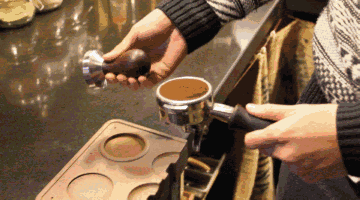
After the cloth powder is finished, hit the side of the powder bowl with a powder hammer to shoot down the loose powder sticking on the inside of the powder bowl. This method can shake off the loose powder, but it is also easy to cause cracks inside the powder pile. For extracted coffee, the variables caused by cracks in the powder pile are obviously greater than those with a small amount of loose powder on the edge of the powder bowl. Therefore, although this method was once popular, but with the popularization and progress of coffee extraction knowledge, it has been abandoned by most coffee practitioners today.
Comments: this is a novice, no, many not new "novice" will also have the bad habits, bad operation. Look at whether the barista in a cafe is professional or not, and see how many knock marks are on the edge of the handle.
six
Scraping and ending method:

At the end of the cloth powder, there is still some excess powder that cannot be paved. You can use tools such as a scraper or directly with your fingers to remove the excess powder and scrape the surface of the powder pile at the same time. Throwing away the scraped powder will cause waste, and if you pour it back into the powder bin to keep it, it will lose its aroma. Therefore, the powder scraping method is a method that can be avoided as far as possible, and it is recommended to use a quantitative bean grinder that can produce powder accurately, or to strengthen training to improve the visual accuracy of baristas when receiving powder.
Comments: many baristas have used the lid of the powder bin of the bean grinder to scrape the excess powder back to the powder bin, and even extend the methods of "flat scraping" and "concave scraping" to different powder quantities and bowls. However, when it comes to quality, this is naturally a very bad operation.
seven
Funnel assist method:

Put the funnel on the powder bowl to help pick up the powder, then shake it in a circle to shake the powder pile flat. This method is recommended when using a quantitative bean grinder. Skillfully mastering the funnel method can avoid flying powder, and the fingers do not have to touch the coffee powder directly, which is a way to distribute powder with many advantages. But only if you find a funnel with the right feel and size.
Comments: most professional contestants will choose this method, and it has become more and more popular in recent years, but in the final analysis, relying too much on "external objects" is not good for baristas to improve their basic skills.
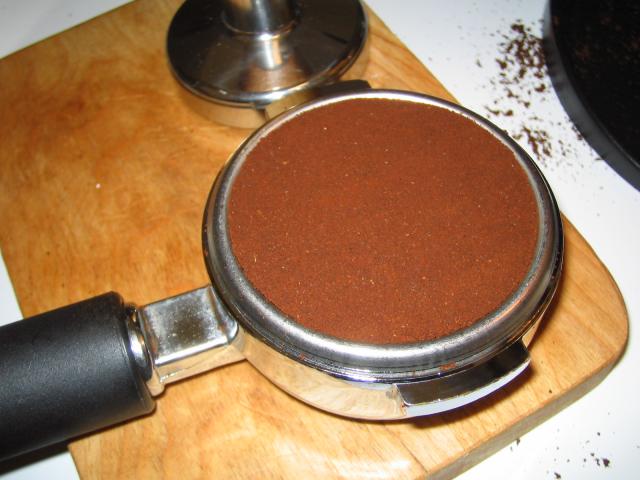
Small summary
In fact, there is a misunderstanding. Cloth powder does not just mean leveling the powder in the powder bowl-coffee powder is cloth powder from the bean grinder falling into the powder bowl to the distribution process before pressing the powder. Never ignore the step of powdering.
The ultimate goal of the cloth powder is to spread the coffee evenly in the whole powder bowl before pressing the powder, not only the surface is smooth, but also there is no gap inside and on the edge of the powder bowl, do not ignore this process, because it will affect the stability of your coffee extraction.
Here's a tutorial video on cloth powder from Gwilym Rhys Davies in the UK, winner of the 2009 World Barista Competition (WBC):
Pressing powder
The purpose of pressing powder: to make the loose coffee powder tight through a certain pressure, so as to let the pressurized hot water permeate evenly.

one
The direction of pressing powder
Straight down. If the pressure is inclined, the high-temperature and high-pressure hot water coming out of the boiling head will seek the infiltration of the layer with the least resistance, resulting in uneven extraction. At the same time, it is easy to have the channel effect that we often talk about. I have explained this too many times.
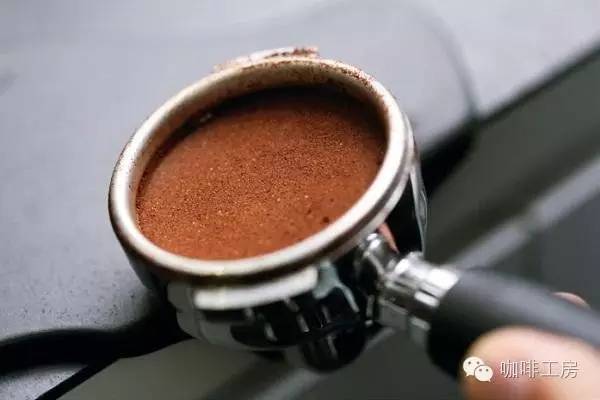
two
The power of pressing powder
The most basic question is how powerful it is and how much kg. I have heard of 25kg before, and I have also heard that Italians regard coffee as their life and touch it gently. In explaining this problem, one of the most basic problems needs to be corrected. Strength should be described by Newton.
If we explain it in terms of Newton, then let's convert it first. 15kg is a more commonly used description, so if it is converted into Newtonian units, it is 15kg*9.8N/KG, which is about 150N.
Then, let's take a look at how much force nine atmospheric jets of water have on Coffee pressed powder. Nine atmospheres means that in a unit square meter, a force equivalent to nine atmospheres is produced, that is, 900KN/ M ^ 2, while the area of our typical 58mm diameter pressed powder is (58pm, 2pm, 1000) ^ 2mm 3.14, that is, about 0.00264 square meters, then the resulting pressure is 90000,000,264 or 2380N.
As a result, the 150N produced by the powder hammer is obviously negligible compared with the flow of 2380N at nine atmospheric pressure.
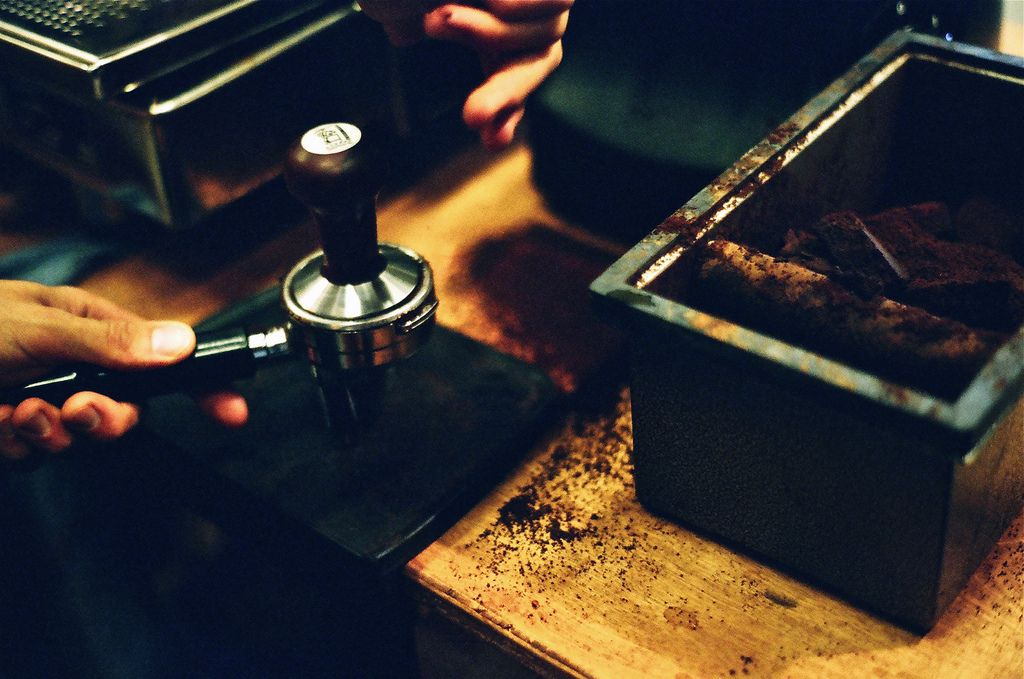
At the same time, there is another important factor to consider. When La Marzocco designed the Swift automatic filling device around 2000, they experimented with forces ranging from 2 pounds to 30 pounds (that is, about 15kg). Found that no matter how much power, the power to the bottom of pressed powder is almost powerless. This is like a car collision experiment, where the extrusion and deformation of the car body itself is the result of absorbing energy.

Small summary
As long as you can understand the above two points, then you will understand: the strength of the powder and what kind of hammer you use does not matter much, as long as you press the powder tightly. Therefore, it is all the more important to keep the powder pressing force consistent every time.
Finally, it is not a good idea to influence the extraction time by pressing powder strength. If you want to adjust the extraction time, it is recommended to investigate the grinding.
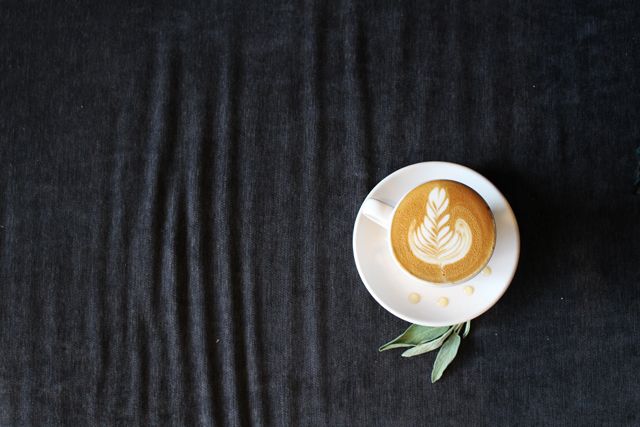
Details determine success or failure
As long as you control the details of cloth powder and pressing powder, and then adjust the grinding degree every day to determine the ratio of water to powder, it is not as difficult as you think to make a perfect cup of Espresso.
Important Notice :
前街咖啡 FrontStreet Coffee has moved to new addredd:
FrontStreet Coffee Address: 315,Donghua East Road,GuangZhou
Tel:020 38364473
- Prev

Full analysis of six commonly used cooking methods! Beginners can steadily play handsome!
Coffee bathes you in luxury, it inspires you to be happy without getting drunk, it triggers your soul to surge and keeps you away from sadness, burnout and weakness. If you are a coffee fan, you will find that a barista who makes coffee carefully is simply handsome in the sky. (shy face) of course, you can also add points to your temperament by making coffee. (handsome face) focus all your attention
- Next
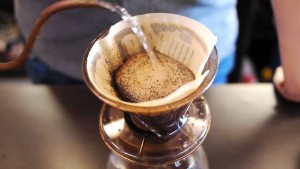
An introduction to the teaching of hand-brewing coffee: the basic knowledge of hand-brewing coffee
Professional baristas Please follow the coffee workshop (official Wechat account cafe_style) in recent years, hand-brewed coffee has gradually become popular in Taiwan. In the era when all kinds of coffee machines are springing up everywhere, hand-brewing coffee with simple utensils and hand-feeling skills is like a clear stream of going back to nature, expanding from Japan, which pursues exquisite culture, so that many coffee experts and people of life are
Related
- What is the meaning of lactic acid fermentation with coffee bean treatment?
- How to judge the state of foam by sound?
- How does the latte pull out the unicorn pattern? Come to get for a little trick to improve the flower pull!
- Will flower pulling affect the taste of the latte?
- Do you know the history of coffee?
- The difference between honey treatment and sun washing what is raisin honey treatment?
- What kind of milk can a novice use to make coffee foam to keep the foam longer? The correct method and skills of milking tutorial sharing
- Why do washed coffee beans taste sour? Flavor characteristics of washed Coffee
- Introduction to the skill of how to practice the size and height of water injection around the circle of hand-brewed coffee
- How do beginners practice coffee flower drawing from scratch?

